Here we are providing Class 12 Geography Important Extra Questions and Answers Chapter 7 Mineral and Energy. Geography Class 12 Important Questions are the best resource for students which helps in class 12 board exams.
Class 12 Geography Chapter 7 Important Extra Questions Mineral and Energy
Mineral and Energy Resources Important Extra Questions Very Short Answer Type
Question 1.
What was the total value of minerals mined in 2012 ?
Answer:
₹ 2.3 crore
Question 2.
What are the total Coal reserves in India in 2012 ?
Answer:
285.38 billion tonnes.
Question 3.
Name two groups of coal Helds.
Answer:
Gondwana and Tertiary.
Question 4.
Where is Mumbai High located ?
Answer:
176 km away from Mumbai in Arabian Sea.
Question 5.
What is the total production of Petroleum in India ?
Answer:
320 lakh tonnes.
Question 6.
Which is the largest Oil refinery in India ?
Answer:
Jamnagar (Gujarat).
Question 7.
What is the total production of Iron ore in India in 2013-13 ?
Answer:
136 million tonnes.
Question 8.
Where was the first Atomic station set up in India ?
Answer:
In 1969 at Tarapur near Mumbai.
Question 9.
Name two sources of non-conventional energy.
Answer:
Biomass and Solar energy.
Question 10.
Name three mineral belts of India.
Answer:
N.E. plateau, S.W. plateau and N.W. Region.
Question 11.
Which state is the largest producer of Coal in India ?
Answer:
Jharkhand.
Question 12.
Which is the largest oil producing area in India ?
Answer:
Mumbai High.
Question 13.
Where was first Electric power house set up ?
Answer:
In 1897 in Darjeeling.
Question 14.
Name any two ferrous (C.B.S.E. 2011)
Answer:
Manganese, Nickle.
Question 15.
What are sustainable energy resources ?
Answer:
Renewable energy resources like Solar energy, Wind, Hydro, geothermal and Bio mass.
Question 16.
Give two advantages of wind energy. Mention four states of India having favourable conditions for the development of wind-energy. (C.B.S.E. 2013)
Answer:
(i) Wind energy is pollution free.
(ii) It is an inexhaustible source of energy. Favourable conditions for wind energy are found in states of Rajasthan, Gujarat, Maharashtra and Karnataka.
Question 17.
Explain any three social and economic values which encourage us to use more and more non-conventional sources of energy. (C.B.S.E. 2014)
Answer:
(i) Planned and judicious use of natural resources.
(ii) Conservation of environment.
(iii) Harmony with nature.
(iv) Sustainable development.
Question 18.
When and where the first successful attempt to tap the underground heat was made?
Answer:
In 1890 in city of Boise, Idaho (USA)
Mineral and Energy Resources Important Extra Questions Short Answer Type
Question 1.
“The non conventional sources of energy will provide more sustained, eco-friendly and cheaper energy, if the initial cost is taken care of.” Examine the statement. (CBSE 2018)
Answer:
Today non conventional sources of energy include wind, tides, geo-thermal heat, biogas, farm and animal waste including human excreta. All these sources are renewable and inexhaustible. They are inexpensive in nature. These are pollution free. These help in decentralisation of industries. Energy can be developed in rural area. These can be developed and maintained at low costs.
Due to acute shortage of conventional sources of energy, it has become necessary to explore the possibilities of using non-conventional sources of energy. These resources are more equitably distributed and environmental-friendly. These will provide more sustainable, eco-friendly and cheaper energies.
Question 2.
What is meant by ‘Mumbai High’ and ‘Sagar Samrat’ ?
Answer:
Mumbai High. Rich oil fields have been discovered in offshore region in gulf of Cambay, along the coast of Mumbai. Oil struck below the sea beds at a distance of 115 kms. from the shore on 19th February, 1974. The drilling was done with the help of Sagar Samrat (A drilling platform). This has become the richest oil field in India and is known as ‘Mumbai High’. It has been connected with the coast by a sub-marine pipeline.
Question 3.
Name the different Nuclear power stations in India.
Answer:
Uranium and Thorium are used as raw materials for generating atomic power. These minerals are found in Bihar, Rajasthan, Tamil Nadu and Kerala. The Atomic Energy Commission was established in 1947 in India. There are four atomic power stations in India.
- Tarapur (Maharashtra)
- Rana Pratap Sagar (Kota)
- Kalpakkam (Chennai)
- Narora (Uttar Pradesh).
Two atomic stations at Kakarpara (Gujarat) and Kaiga (Karnataka) are at planning stage.
Question 4.
What is bio-energy ? State four advantages of bio-energy. (C.B.S.E. 2013
Answer:
Bio-energy refers to energy derived from biological products which includes agricultural residues, along with municipal, industrial and other works,
Advantages:
(i) It is a potential source of energy conversion.
(ii) It can be converted into electrial energy, heat energy or gas for cooking.
(iii) It can process waste to produce energy.
(iv) It reduces environmental pollution.
Question 5.
Give two advantages of copper. Mention four main copper mining areas of India. (C.B.S.E. 2013)
Answer:
Copper is an indispensable metal in the electrical industry for making wires, electrical motors, transformers and generators. It is also mixed with gold to provide strength to jewellery. Copper deposits are found in:
- Singhbhum district in Jharkhand
- Balaghat in Madhya Pradesh
- Jhunjhuna in Rajasthan
- Alwar in Rajasthan
Question 6.
Describe the regions producing Natural gas in India. Describe H.B.J. pipeline.
Answer:
Natural gas has emerged as a dynamic source of energy. The total production of Natural gas is 40.674 billion cubic metres in India (2012). Cambay basin, Kaveri coast, Jaisalmer and Mumbai High are the main producers of Natural gas. H.B.J. gas pipeline has been constructed for transporting gas running between Hazira, Bijapur and Jagdishpur.
It is 1700 km. long and runs through the states of Gujarat, Madhya Pradesh, Rajasthan and Uttar Pradesh. This pipeline will supply gas to Bijapur, Sawai Madhopur, Jagdishpur, Shahjahanpur, Amla, Babrala fertiliser plants.
In India, Gas Authority of India Ltd. (GAIL), Oil and Natural Gas Commission (ONGC), Indian Oil Corporation (IOC) and Hindustan Petroleum Corporation (HPC) are exploring and managing gas resources.
Question 7.
Describe the ‘Iron ore belt of India’.
Answer:
The total reserves of iron ore in the country were about 28.52 billion tonnes in the year 2012. About 95 per cent of total reserves of iron ore is located in the States of Odisha, Jharkhand, Chhattisgarh, Karnataka, Goa, Andhra Pradesh and Tamil Nadu. (1) In Odisha, iron ore occurs in a series of hill ranges in Sundergarh, Mayurbhanj and Keonjhar. The important mines are Gurumahisani, Sulaipet, Badampahar (Mayurbhanj), Kiruburu (Kendujhar) and Bonai (Sundergarh).
(2) Similar hill ranges such as Jharkhand have some of the oldest iron ore mines and most of the iron and steel plants are located around them. Most of the important mines such as Noamandi and Gua are located in Poorbi and Pashchimi Singhbhum districts.
(3) This belt further extends to Durg, Dantewara and Bailadila. Dalli, and Rajhara in Durg are the important mines of iron ore in the country.
(4) In Karnataka, iron ore deposits occur in Sandur-Hospet area of Bellary district, Baba Budan hills and Kudremukh in Chikmangalur district and parts of Shimoga, Chitradurg and Tumkur districts.
(5) The districts of Chandrapur, Bhandara and Ratnagiri in Maharashtra.
(6) Karimnagar, Warangal, Kurnool, Cuddapah and Anantapur districts of Andhra Pradesh.
(7) Salem and Nilgiris districts of Tamil Nadu are other iron mining regions.
(8) Goa has also emerged as an important producer of iron ore.
Question 8.
Distinguish between Ferrous and Non- ferrous minerals.
Answer:
| Ferrous Minerals | Non-Ferrous Minerals |
| 1. The metallic minerals which contain iron content are called ferrous minerals (Fe).
2. Iron, Manganese. Chromite, Cobalt, etc., are ferrous minerals. 3. These are used in Iron and Steel industry. Some minerals are used as alloys in making different types of steel. |
1. The minerals which do not contain iron (ferrous) content are called non- ferrous minerals.
2. Copper. Lead, Zinc. Aluminium are non- ferrous minerals. 3. Each mineral has its particular utility. Some minerals are valuable according to their uses. |
Question 9.
Distinguish between Metallic and Non- metallic minerals
Or
Classify minerals on the basis of chemical and physical properties. (C.B.S.E. Outside Delhi 2017)
Answer:
| Metallic Minerals | Non-Metallic Minerals |
| 1. Metallic minerals are those minerals which can be melted to obtain new products.
2. Iron, Copper, Bauxite, Tin, Manganese are some examples. 3. These are generally associated with Sedimentary and Igneous rocks. 4. These can be reused after melting. |
1. Non-metallic minerals are those which do not yield new products on melting.
2. Coal, Salt, Clay. Marble are some examples. 3. These are generally associated with rocks. 4. These cannot be used after melting. |
Question 10.
Distinguish between Rock and Mineral ore.
Answer:
| Rock | Mineral Ore |
| 1. A rock is a natural solid material forming the earth crust.
2. A rock is an aggregate of minerals such as granite, marble, etc. 3. A rock does not have a definite chemical composition. 4. Rocks are mainly of three types—Igneous, Sedimentary and Metamorphic. |
1.A mineral is, a natural inorganic compound found in the rocks.
2. Some rocks contain only one mineral and are called mineral ores such as iron ore. 3. It has definite chemical composition. 4. There are about 2000 types of minerals. |
Mineral and Energy Resources Important Extra Questions Long Answer Type
Question 1.
Describe the production and distribution of Iron ore in India.
Answer:
Iron Ore. Iron is the most useful of all metals. It has strength, hardness and magnetic properties. Iron has become the basis of modern industrialisations. It has revolutionised modern means of land, air, and water transportation. India is rich both in quality and quantity of iron ore deposits. India ranks seventh in the world with 5% production of iron ore. The iron ore deposits mainly consist of hematite and magnetite deposits with an iron content of 60 to 70%.
Production and reserves: India has iron ore reserves (about 7% of the world) about 28.82 million tonnes. Most of these deposits are in Jharkhand and Odisha state. These deposits are the world’s richest and largest deposits.
Distribution of Iron Deposits: Jharkhand and Odisha produce about 75% of total production of iron ore in India. This is called ‘iron ore belt of India’. Major steel plants of India are located in this region.
- Jharkhand: Noamandi and Gua mines in Singhbhum district and Hazaribagh district of Jharkhand state.
- Odisha: Keonjhar, Mayurbhanj, Bonai districts.
- Chhattisgarh: Dhali-Rajhara hills (Durg) and Bailadila (Bastar) in Chhattisgarh state.
- Tamil Nadu: Salem and Madurai.
- Other areas: Baba Budan Hills and Kudremukh in Karnataka, Kurnool in Andhra Pradesh, Lohara, Ratnagiri and Pipalgaon in Maharashtra,
Salem and Tiruchirapalli in Tamil Nadu and Goa.India exports iron ore to Japan and some other countries. The total value of iron ore exports in 2011¬12 was ₹ 33911.7 crores. The port of Mormugao, Vishakhapatnam, Paradip and Mangalore handle these exports.
Question 2.
Describe the production and distribution of coal in India.
Answer:
COAL. Coal is the prime source of energy. It is often called the ‘Mother of Industries’ or ‘Black gold’. It has been the basis of the Industrial Revolution. Coal is used as a raw material in iron and steel, chemical industries. Coal is the main source to produce thermal power.
India ranks seventh in the world as regards of the coal reserves. The total proven coal reserves are nearly 2,93,496.5 million tonnes. These reserves will not last long. The major states known for coal reserves are Jharkhand, Odisha, West Bengal, Madhya Pradesh, Andhra Pradesh and Maharashtra.
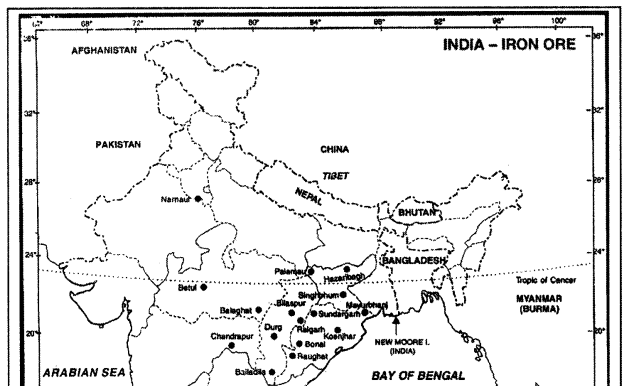
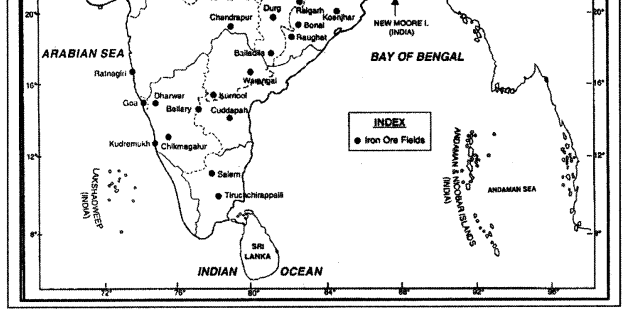
Production. Coal production started in 1774 in Raniganj coal field (West Bengal). After independence, production of coal increased 6 times.
The per capita consumption of coal has increased from 135 kg to nearly 400 kg.
Distribution. India has two types of coal fields:
(a) Gondwana coal fields (98%)
(b) Tertiary coal fields (2%)
(a) Gondwana coal fields. These belong to the period of Gondwana age. Nearly 3/4th of coal deposits are found in Damodar valley (Damuda series). Godavari, Mahanadi, Son and Wardha valley also have coal deposits.
(i) West Bengal. West Bengal has the oldest coal field of India at Raniganj. It covers an area of 1267 sq. km and the total reserves is 30616 million tonnes.
(ii) Bihar and Jharkhand State. This region produces 50% coal of India. The major coal fields of Jharia, Bokaro, Karanpura, Daltonganj are found in
Damodar valley. Coking coal from this coal-field is supplied to steel centres of Jamshedpur, Asansol, Durgapur production of coal increased 6 times.
The per capita consumption of coal has increased from 135 kg to nearly 400 kg.
Distribution. India has two types of coal fields:
(a) Gondwana coal fields (98%)
(b) Tertiary coal fields (2%)
(a) Gondwana coal fields. These belong to the period of Gondwana age. Nearly 3/4th of coal deposits are found in Damodar valley (Damuda series). Godavari, Mahanadi, Son and Wardha valley also have coal deposits.
(i) West Bengal. West Bengal has the oldest coal field of India at Raniganj. It covers an area of 1267 sq. km and the total reserves is 30616 million tonnes.
(ii) Bihar and Jharkhand State. This region produces 50% coal of India. The major coal fields of Jharia, Bokaro, Karanpura, Daltonganj are found in
Damodar valley. Coking coal from this coal-field is supplied to steel centres of Jamshedpur, Asansol, Durgapur and Bokaro. Bihar contributes only 160 million tonnes, where as Jharkhand contributes 80356 million tonnes of coal to india (2012).
(iii) Madhya Pradesh. Madhya Pradesh has Son valley, coal-fields of Suhagpur, Korba, (Chhattisgarh), Rampur, Tatapani, Singrauli. Total reserves in 24376 million tonnes.
(iv) Other areas. Singareni in Andhra (22154.8 m.t.) Talchar in Mahanadi valley, Chanda-Wardha coal¬fields of Maharashtra (10882 m.t.).
(b) Tertiary coal Helds. This includes lignite deposits called brown coal of low quality. These include Neyveli deposits (3300 million tonnes) in Tamil Nadu, producing 600 MW of thermal power. Other areas are Makum (Assam) producing 510.5 million tonnes, Bikaner (Rajasthan), Garo Khasi Hills (576.5 m.t.), Riasi in Jammu and Kashmir
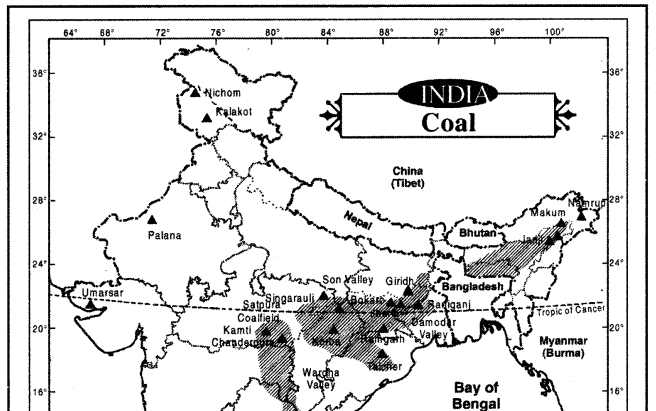
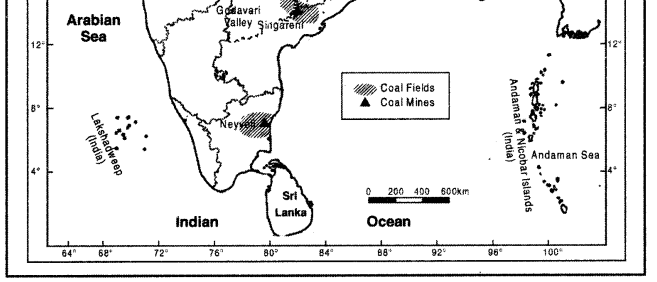
Question 3.
Describe the production and potential areas of production of Petroleum in India.
Or
Why is petroleum referred to as liquid gold? State two important uses of petroleum and name two oil fields each in Assam and Gujarat.
Ans.
Petroleum. Petroleum is the most important source of power in the present age. Many by-products such as kerosene, fuel, lubricating oils, grease, coke and asphalt are obtained from petroleum. Petrochemical products have become very useful. Petroleum is used in agriculture, industry, transport, paints, perfumes, cosmetics, etc.
It is the source of foreign exchange for many oil exporting countries. So it is rightly called the ‘liquid gold’.
Production. In about 10 lakh sq. km. oil bearing rocks are found in India. The oil reserves in India are estimated to be 759.6 million tonnes. The first oil field in India was discovered in 1867 at Makum in Assam. At present, the
production is as under:
- Assam. In Assam, oil is produced in Digboi, Moran, Naharkatiya and Sibsagar regions. It contributes 22.71% of total reserves.
- Gujarat. In Gujarat, oil is produced in Gulf of Cambay region at Kalol, Ankleshwar, Lunej, etc.
- Maharashtra. Oil has struck in the off-shore region at Mumbai High along the coast of Mumbai. It is the leading producer of crude oil in India. North Bassien and South Bassien are the important oil fields.
The production of oil in India is increasing everywhere under the organization of Oil and Natural Gas Commission (ONGC). The production of oil in India rose from 37.862 million metric tonnes in 2012. India meets about 40% of our demands by home production. We import crude oil from foreign countries and other petroleum products also. There are at present 17 oil refineries in India. These refineries are expanded to meet the increasing requirements of the country. It will help in saving a large amount of foreign exchange.
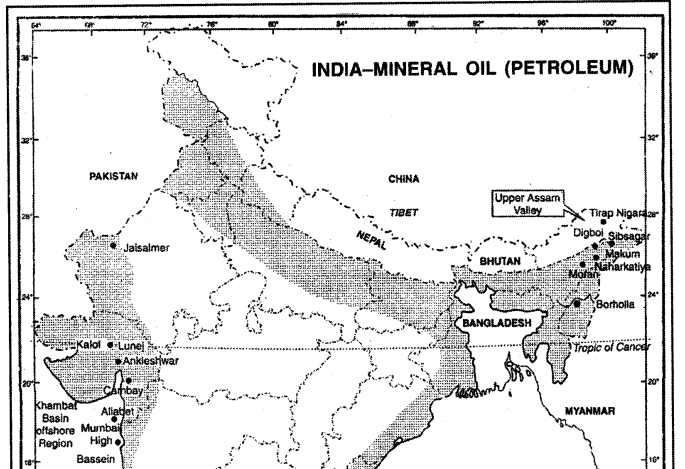
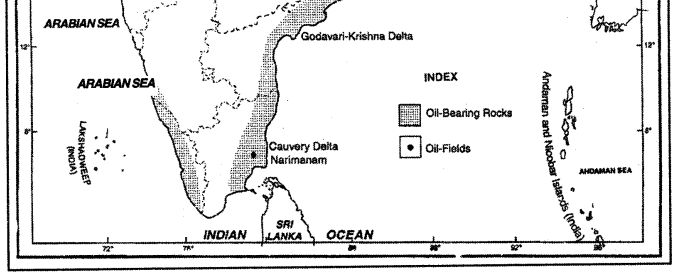
Oil-Refineries. There are already 17 refineries in the country. These refineries include
(i) Barauni (Bihar)
(ii) Mumbai (Maharashtra)
(iii) Kochi (Kerala)
(iv) Digboi (Assam)
(v) Guwahati (Assam)
(vi) Haldia (West Bengal)
(vii) Vishkhapatnam (Andhra Pradesh)
(viii) Koyali (Gujarat)
(ix) Chennai (Tamil Nadu)
(x) Mathura (U.P.)
(xi) Panipat (Haryana)
(xii) Bongaigaon and Numaligarh (Assam)
(xiii) Jamnagar (Gujarat)
(xiv) Mangalore (Karnataka)
(xv) Nagapattinam (Tamil Nadu)
(xvi) Bina (Madhya Pradesh)
(xvii) Bhatinda (Punjab).
These refineries also supply cooking gas or Liquefied Petroleum Gas (L.P.G.) as domestic fuel. It has succeeded in reducing demand on our shrinking forests.
Natural Gas. Natural gas is obtained from the oil fields. It is a prime source of energy for cooking in domestic field. It is called L.P.G. and is supplied through pipelines. Reserves of Natural gas are located in Tripura, Rajasthan, Gujarat, Tamil Nadu, Andhra Pradesh and Odisha .
The production is about 40.8 billion cubic metres. A gas pipeline, from Hazira, (Gujarat) Bijapur to Jagdishpur (U.P.)-1700 km long has been constructed to produce fertilisers at different plants at Bijapur, Sawai Madhopur, Jagdishpur, Shahjahanpur, Anwala and Barbala.
Question 4.
Describe the development of Nuclear energy in India.
Answer:
Nuclear Energy. Nuclear energy is generated by splitting atomic minerals. The process is called atomic fission. Uranium, Monazite, Thorium, Placer deposits, Cheralite, Graphite and Zirconium are used for generation of nuclear power of atomic energy. India is rich in these minerals.
The Bhabha Atomic Research Centre has been set up at Trombay (Maharashtra) for research in Nuclear Science. The first underground Nuclear Test was conducted on May 18,1974 at Pokhran (Rajasthan). Recently five underground Nuclear Tests were conducted at Pokhran, on 11th May, 1998. Thus, India became a nuclear power country.
Uranium and Thorium are used as raw materials for generating atomic power. These minerals are found in Bihar, Rajasthan, Tamil Nadu and Kerala. The Atomic Energy Commission was established in 1947 in India. There are 7 atomic power stations in India with an installed capacity of 5780 million KW:
- Tarapur (Maharashtra).
- Rana Pratap Sagar or Rawat Bhata (Kota, Rajasthan).
- Kalpakkam (Chennai, Tamil Nadu).
- Narora near Bulandshahar (Uttar Pradesh).
- Kaiga (Karnataka)
- Kakrapar (Gujarat)
- Kundankulam (Tamil Nadu)
Two atomic power stations at Kakarpara (Gujarat) and Kaiga (Karnataka) are at planning stage.
Nuclear Energy-Hope of the Future. The use of atomic energy is increasing in the field of medicine and agriculture. It is being used to improve the quality of seeds. It can be used for exploring the mineral wealth of India. Atomic energy is being used in India for many peaceful purposes like development of man-made lakes, diversion of rivers, and use in medical science. India is rich in atomic minerals like Uranium and Thorium.
Therefore, this energy can be generated easily and will last for a long period. There is shortage of coal, petroleum and water power in India. In such areas, Nuclear Energy plays a complementary role in the development of Industries. Conventional sources of energy will not last long. Nuclear power should be used to save the resources. These power stations though expensive can be easily set up. We can say ‘Nuclear energy is the hope of the future in India.’
Question 5.
Write a note on the development of non-conventional sources of energy in India.
Or
Explain the importance of five non. conventinal sources of energy with suitable examples. (CJS.S.E Outside Delhi 2017)
Answer:
Non-Conventional Sources of Energy. Today non-conventional sources of energy include wind, tides, geo-thermal heat, bio-gas, farm and animal waste including human excreta. All these sources are renewable or inexhaustible. They are inexpensive and pollution free. These help in decentralisation of Industries. Energy can be developed in rural areas and maintained at low costs.
Due to acute shortage of conventional sources of energy, it has become necessary to explore the possibilities of using non-conventional sources of energy. A Ministry of Non-Conventional Energy Sources (MNES) has been created in 1992 for this purpose. Its achievements so far are as under:
| S.No. | Source | Potential | Achievement |
| 1. | Wind-power | 49130 MW | 2980 MW |
| 2. | Biomass power | 17538 MW | 1693 MW |
| 3. | Solar power | 20 MW/ Sq. km. | 941.24 MW |
| 4. | Power from urban wastes | 1700 MW | 4.75 MW |
| 5. | Water Heating systems | ……………. | 4,20.000 |
| 6. | Solar Cookers | ……………. | 4,57.000 |
| 7. | Biogas plants | 12 million | 2.5 million |
| 8. | Improved Chullahas | 120 million | 23.7 million |
Wind energy. It can be used for pumping water, irrigating farms and generating electricity. The states of Gujarat, Tamil Nadu, Maharashtra and Odisha are better placed in regard to this energy. Wind mills are established in areas of high speed winds. India has a potential of 49130 MW of
power generation. The first wind farm was set up at Mandavi (Gujarat) in 1986. The Turbines of wind mills are rotated with the force of wind velocity. At present wind farms of capacity of 970 MW have been installed. India is the third country in the world to develop wind power on a large scale. There are about 3000 wind mills installed in various states in India.
2. Tidal energy. The Gulfs of Kachchh and Cambay are ideally suited to develop electricity from the energy produced by high tides entering into narrow creeks. A 900 MW tidal power station is being set up in Gulf of Kachchh. It is an inexhaustible and inexpensive source of energy.
3. Geo-thermal energy. Efforts are on to utilise natural energy of the hot springs at Manikaran in Himachal Pradesh, Puga, Parvati valley, Tattapani are other sites. Hot water is converted into steam to drive the turbines. Hot springs are used for heating purposes. India has a potential of 10600 MW of power from it.
4. Energy from urban waste. Sewage in cities is used for generating gas and electricity. Various wastes are treated such as sewage waste, vegetable waste, waste from leather, sugar, paper industries. A 4 MW energy plant at Delhi, 2.76 MW energy plant using husk in Andhra, 1MW plant at Faizabad Distillery, have been established. About 145 million tonnes of agricultural waste can generate 14000 MW power. Energy from plantations and bagasse is also developed.
5. Bio-gas based power plants. Bagasse, farm wastes, rice husk are being used to produce electricity. The National Project on Biogas was set up in 1981-82. It provides a clean and cheap source of energy in rural areas. Upto now 25 lakh Biogas plants have been installed, saving 75 lakh tonnes of fuel wood per year valued at ? 375 crore. Besides these plants generate 360 lakh tonpes of enriched manure. Smokeless chullahas (28 million) remove smoke, pollution and check deforestation and save 115 lakh tonnes of fuel wood.
6. Farm animal and human wastes (Urja Gram). By using biomass, animal, poultry wastes and human excreta, gobar gas plants are being set up in villages. The power so produced is used for cooking, lighting homes and streets and meeting irrigation needs of the village. A pilot plant (4 MW) has been set up in Delhi for the conversion of urban waste into energy.
7. Solar Energy. It is the most abundant, cheapest and inexhaustible source of energy produced from sunlight. Solar cookers are used in cooking food. Solar power is being used for cooking, water heating, water desalination, space heating, crop drying. Solar energy is used for solar lanterns, street lights, railway signals, traffic signals (as in Delhi), rural telephones, TV, radios, etc. In remote areas of Coimbatore, two projects of 25 KW provide energy. The Sagar island in West Bengal is completely solarised.
Solar cells convert the solar energy to electricity. Solar energy is the future energy in India because India receives abundant sunshine almost throughout the year to develop it.
Question 6.
Describe the distribution of mineral belts of India.
Answer:
The following three major mineral belts can be demarcated within the peninsular plateaus.
1. The North-Eastern Plateaus. It encompasses the Chotanagpur plateau, Odisha plateau and eastern Andhra Plateau.
This belt contains rich deposits of a variety of minerals used in metallurgical industries. Among them, reserves of iron ore, manganese, mica, bauxite, limestone and dolomite are large and widely distributed. This region also has copper, thorium, uranium, chromium, sillimanite and phosphate.
Along with them, coal deposits of the Damodar valley and Chhattisgarh which have facilitated the development of heavy industries are within this belt. Majority of the integrated iron and steel plants are located in this belt. Aluminium plants are also located here.
2. South-Western Plateaus. This belt extends over the Karnataka plateau and adjoining Tamil Nadu plateau and is rich in metallic minerals, particularly in iron ore, manganese and bauxite and in some non- metallic minerals. But the lack of power resource particularly coal has been an obstacle in the way of the development of heavy industries in this region. All the three gold fields of the country are located in this belt.
3. North-Western Region. This belt extends from the Gulf of Khambhat in Gujarat to the Aravalli range in Rajasthan. Petroleum and Natural gas are principal resources of this belt. Deposits of other minerals are small and scattered. However, it is known for reserves and production of several non-ferrous metals particularly copper, silver, lead and zinc.
4. Other Regions. Outside of these mineral belts, Upper Brahmaputra valley is a significant petroleum producing area. Kerala possesses enormous concentration of heavy mineral sands. Mineral deposits are also found in other parts of the country but they are scattered and reserves are inconsistent.
Mineral and Energy Resources Important Extra Questions HOTS
Question 1.
Why is the conservation of minerals necessary ? Explain any two methods of conserving minerals. (C.B.S.E. 2011)
Answer:
Minerals are a valuable natural resource. Minerals are exhaustible and limited resources. These are non-renewable resources. Once these are used, these are gone forever. Conservation of minerals means a careful and rational utilization so that these can also be used for future generation.
For conservation of minerals, their substitutes should be used such as Aluminium is used in place of copper. Scientific methods of mining should be used to avoid wastage of minerals.
Question 2.
Give two advantages of I manganese. Mention four main I manganese producing states of India. (C.B.S.E. 2013)
Answer:
Manganese is an important raw material for smelting of iron ore. It is also used for the manufacturing of ferro-alloys.
Production:
- Odisha is the leading producer of manganese.
- Karnataka is also major producer of manganese.
- Maharashtra
- Andhra Pradesh
- Madhya Pradesh